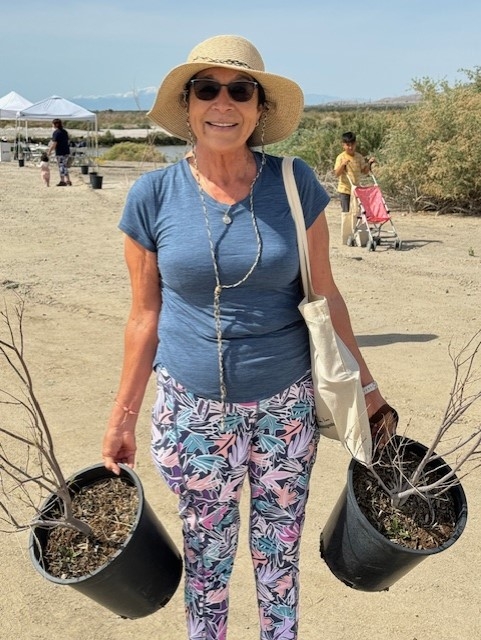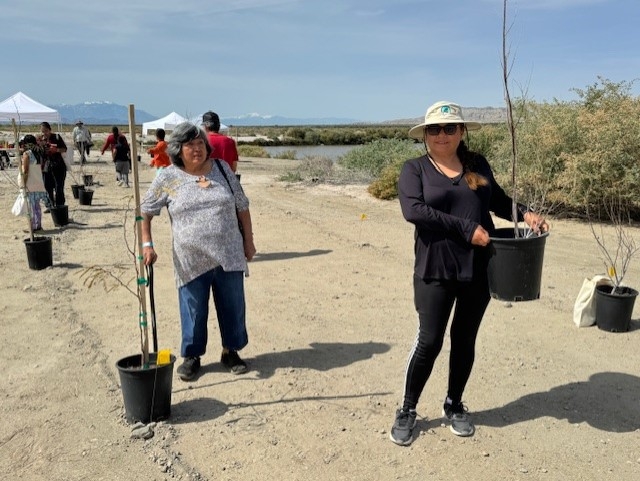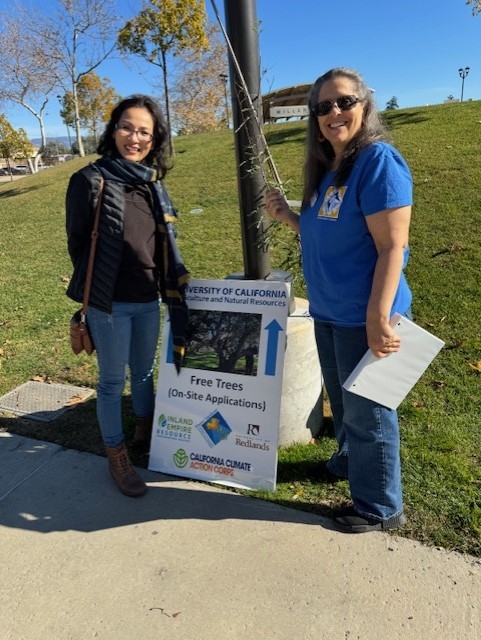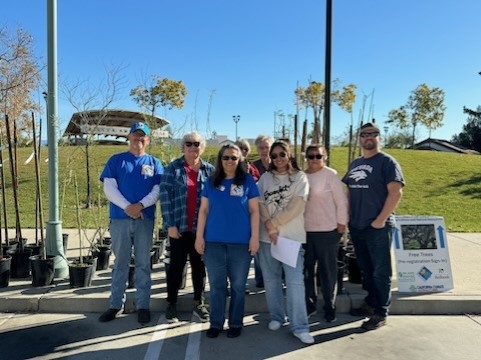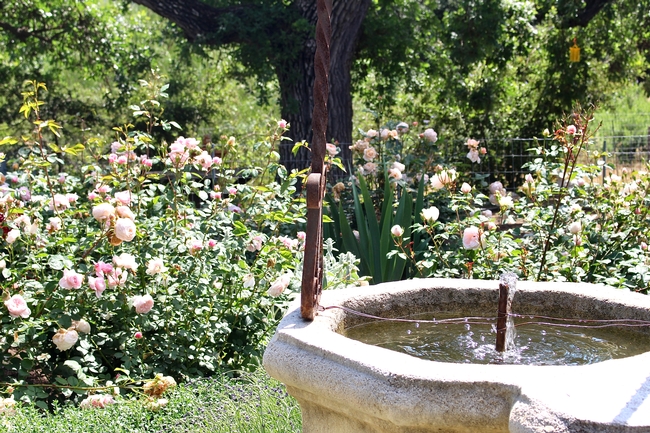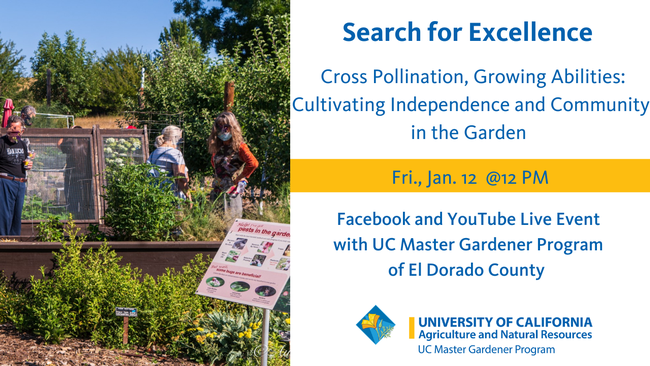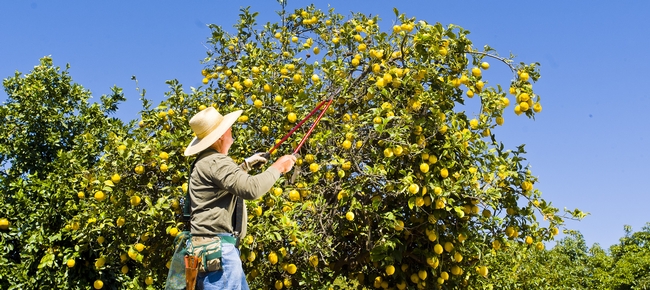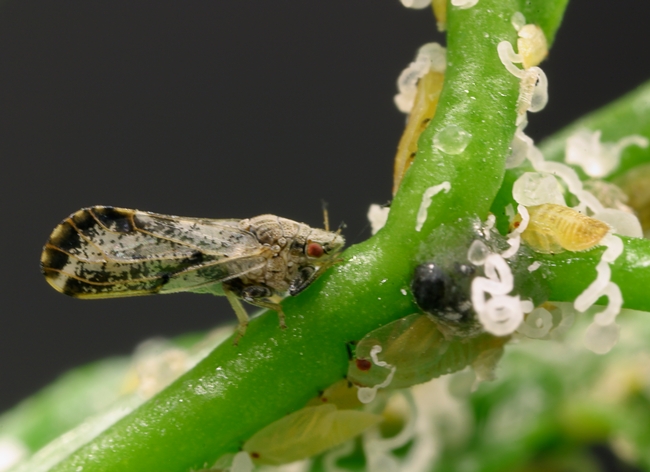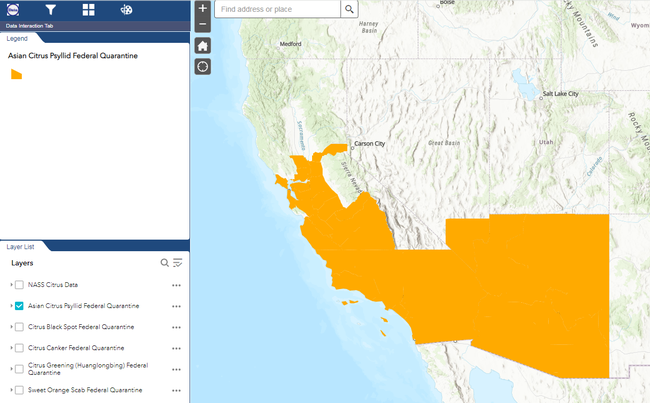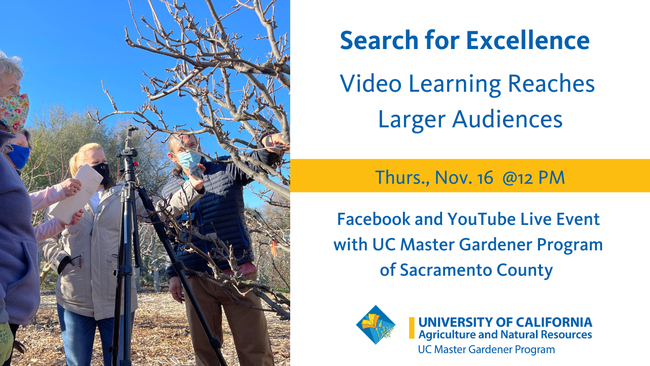Posts Tagged: Garden
1,800 Climate-Ready Trees Provided to Residents of Low Shade Neighborhoods
To date, over 1,800 climate-ready shade trees and tips on their planting and long-term care have been provided by UC Master Gardeners and over 20 partners to residents of low shade neighborhoods in San Bernardino and Riverside Counties through the “Trees for Tomorrow Start Today” project. Tree species given away are identified from research projects including the joint University of California/United States Forest Service (USFS) study at UC Riverside as well as from other research, local observations, and input from the green industry and academic colleagues.
The "Trees for Tomorrow Start Today" project was implemented in 2019 by Area UC Cooperative Extension Horticulture Advisor Janet Hartin with support from the Inland Empire Resource Conservation District. A "train the trainer" model provided education to Master Gardener volunteers from San Bernardino County on project elements and follow-up. Master Gardeners now manage many of the events. In 2023, the program expanded into Riverside County. Several other Master Gardener programs throughout the state have also expressed interest in implementing the "Trees for Tomorrow Start Today" project.
Why is this project so important? 95% of Californians now reside in cities and suburban environments. Resulting urban heat islands created by built environments coupled with impacts of climate change can be mitigated through nature-based solutions. Planting climate-ready shade trees now will help ensure cooler urban areas in the next several decades as trees mature and maximize their urban ecosystem benefits. Fortunately, the shade from a single well-placed tree can decrease surface temperatures of black asphalt and artificial turf by more than 70 degrees F in hot inland and desert cities. Studies show that surrounding air temperatures can also be reduced through the transpiration process.
A major goal of the"Trees for Tomorrow Start Today" project is to enhance tree canopy cover in low shade neighborhoods also plagued with much higher than average levels of air pollution and pulmonary and cardiovascular disease incidence. Events over the past month have occurred in Fontana, San Bernardino, and the Salton Sea.
Other partners include San Bernardino County, City of San Bernardino, California Climate Action Fellows, Tree People, Coachella Valley Resource Conservation District, Alianza Coachella Valley, Inland Empire Urban Conservation Corps, several water districts, and other groups.
Thank you to all our partners and, especially, our tree recipients, for greening and cooling your yard and neighborhood!
Pruning Roses and Cultivating Beauty
Pruning roses is not just a chore; it's an important practice for nurturing vibrant, healthy roses and fostering the beauty of your garden. In California, where the climate is favorable for growing roses, understanding the significance of pruning is key to achieving thriving and healthy roses.
Why Prune?
Pruning isn't merely about maintaining a tidy appearance; it's about promoting the overall well-being of your roses:
- Annual pruning stimulates plant and shoot growth, leading to larger blooms and a more robust structure.
- Removing dead, damaged, or diseased canes minimizes the risk of fungal infections and pest infestations, fostering plant health.
- Thinning out dense growth improves air circulation within the plant, reducing the likelihood of fungal diseases like powdery mildew and black spot.
- Shaping the plant through pruning enhances its visual appeal, creating a more attractive landscape.
When to Prune
Timing is important when it comes to pruning roses. In California, where winters are mild, the ideal time for pruning is typically between late winter and early spring. Pruning during dormancy allows the plant to focus its energy on new growth when spring arrives.
How to Prune
Pruning may seem daunting, but with the right approach, it becomes a manageable task:
- If the plant is dormant (recommended), remove all remaining leaves.
- Use sharp, clean pruning shears and loppers to make precise cuts, minimizing damage to the plant.
- Trim back old growth by about one-third to improve visibility and encourage new growth. Remove dead, diseased, or crossing canes to maintain a healthy structure.
- Make pruning cuts approximately ¼-1/2” above an outward-facing bud. Pruning cuts should be at a 45-degree angle, sloping away from the outward-facing bud.
- Create an open, vase-like shape by removing canes from the center of the plant. This promotes airflow and sunlight penetration, which is essential for plant health.
- Clear away debris and old leaves to prevent disease spread. Consider applying insecticidal soap or horticultural oil during dormancy to control pests.
Conclusion
Pruning roses is a fundamental aspect of rose care that should not be overlooked. By understanding the importance of pruning and following basic pruning principles, you can nurture thriving roses that add beauty and vitality to your garden year after year. For more details on growing roses and pruning timelines for your area contact your local UC Master Gardener Program.
Facebook Live: Search for Excellence, Cross Pollination, Growing Abilities: Cultivating Independence and Community in the Garden
Join us on Facebook on Friday, January 12 for a LIVE event as we learn about El Dorado County's award-winning project, "Cultivating Independence and Community in the Garden." The UC Master Gardeners of El Dorado County, in partnership with CalFresh Healthy Living and Mother Lode Rehabilitation Enterprises (MORE), created a community garden in California's El Dorado County that served as more than just a gardening space. It offered life skills, self-confidence, and fostered a strong sense of community. Their efforts to provide equal opportunities and inclusivity for adults with disabilities at MORE was recognized as one of the Search for Excellence winners. In a world often focused on individual achievement, this project serves as a reminder of the transformative power of community and collaboration.
No registration or special link needed, the talks will be streamed LIVE to Facebook and YouTube.
Speakers:
Tracy Celio, Program Manager Central Sierra, UC Master Gardener Program
Diane Hernandez, UC Master Garden Volunteer El Dorado County
Cailin McLaughlin, CalFresh Healthy Living, Garden Coordinator
Date: Friday, January 12
Time: Noon
Link: https://fb.me/e/8ntmrDNJd
Facebook Live is an authentic and interactive way to interact with our audience in real time. It also allows the ability to build value, trust and raise brand awareness of the UC Master Gardener Program. Share the Facebook Live opportunity on your personal and local program pages and tune in to the UC Master Gardener Program Facebook Live broadcast! Let us know in the comments section what topics or questions you would like answered on Monday or on future Facebook Live topics.
Citrus Care in the Sharing Season - Help Prevent the Spread of Asian Citrus Psyllid (ACP)
As gardeners, we're often generous with our garden's bounty. From sharing seeds and plant trimmings to the joy of gifting homegrown fruit and vegetables, gardening is as much about community as it is about growing plants. However, in this season of sharing, we must also remember our responsibility to prevent the spread of pests and invasive species to protect California's diverse ecosystem.
First detected in California in 2008, Asian citrus psyllid (ACP) has been a concern for both commercial citrus growers and home gardeners. ACP poses a significant threat to California's citrus trees, capable of spreading the deadly huanglongbing (HLB) disease, an incurable condition that eventually kills the tree.
Detecting ACP involves looking for a few key characteristics. ACP is a tiny, mottled brown insect about the size of an aphid. Adults are typically 3 to 4 millimeters long and are identified by their distinctive body shape, where the head is narrower than the body, and they hold their wings tent-like over their bodies. They are most active during warm temperatures, and you might notice them jumping or flying when disturbed. The nymphs, the immature form of the psyllid, are yellowish-orange and secrete white, waxy tubules from the back of their abdomen.
Additionally, ACP leaves telltale signs on citrus leaves, such as twisted or curled new leaf growth. They are sap-feeders, like aphids and mealybugs, so they produce honeydew which leads to the growth of sooty mold. Regularly inspecting your citrus trees, especially the new growth, is key to early detection of ACP.
Recent updates to the USDA's Plant Protection and Quarantine citrus map highlights areas that are generally infested with ACP and those which are not. This distinction is crucial for understanding the regulations and eradication efforts in different regions across the state. To find detailed quarantine information by county or zones, visit the California Department of Food and Agriculture (CDFA) ACP Regulation and Quarantine Boundaries website and maps.
Looking at the map pictured above, areas in the southern region of California, south of the Grapevine or San Gabriel and Tehachapi Mountain Ranges, and as far up the coast as Santa Barbara County are considered generally infested. The CDFA does not carry out eradication efforts for ACP in these areas. In areas north of the Grapevine, an ACP detection on a residential citrus tree would trigger an eradication response from the CDFA.
As we approach the holiday season, a popular time for gardeners to share budwood for grafting, it's crucial to understand the importance of not moving citrus planting material between quarantine areas. It is especially important not to move budwood or citrus from Southern California or the Bay Area into California's Central Valley.
To aid in this effort, UC Master Gardener Program resources are available to help educate you about identifying ACP and understanding the quarantine regulations. Here are some key actions you can take:
- Only purchase new citrus trees from reputable nurseries.
- Do not accept tree cuttings or budwood from friends or family.
- After pruning or removing a citrus tree, dry out the green waste or double bag it to help ensure the green waste is disposed of appropriately.
- Control ants in and near citrus trees with bait stations. Scientists have released natural enemies of ACP in Southern California to help keep the pest in check, but ants aid ACP in evading the natural enemies.
The UC Agriculture and Natural Resources ACP website offers an interactive map tool, biological control efforts, and an online calculator for the potential costs of using insecticides. Additionally, the Statewide UC Integrated Pest Management website provides free online training for gardeners and detailed Pest Notes on ACP and HLB disease. Remember, inspecting your citrus trees is vital to prevent the spread of ACP and HLB. If you suspect an infestation, contact the CDFA Exotic Pest Hotline at 1 (800) 491-1899 or your local county agricultural commissioner.
Let's continue to share the bounties of our gardens, but let's do so responsibly, keeping our citrus trees safe and healthy. Together, we can make a difference in the fight against ACP and HLB.
Facebook Live: Search for Excellence, Video Learning Reaches Larger Audience
Join us on Facebook on Thurs., Nov. 16 for a LIVE event as we learn about Sacramento County's award-winning project, "Video Learning Reaches Larger Audiences." This project was recognized for being innovative and has encouraged other programs across California to make videos that are informational, easy to watch and engaging. Their dedication to helping their community was especially clear during the pandemic, showing their willingness to adapt and keep delivering the UC Master Gardener mission.
No registration or special link needed, the talks will be streamed LIVE to Facebook and YouTube.
Date: Thursday, Nov. 16
Time: Noon
Link: https://fb.me/e/39IoRvOdg
Speakers:
Kathy Steuer, UC Master Gardener Volunteer Sacramento County
Mary Welch, UC Master Gardener Volunteer Sacramento County
Facebook Live is an authentic and interactive way to interact with our audience in real time. It also allows the ability to build value, trust and raise brand awareness of the UC Master Gardener Program. Share the Facebook Live opportunity on your personal and local program pages and tune in to the UC Master Gardener Program Facebook Live broadcast! Let us know in the comments section what topics or questions you would like answered on Thursday or on future Facebook Live topics.
Find recording of LIVE events here: LIVE Series - UC Master Gardener Program (ucanr.edu)





